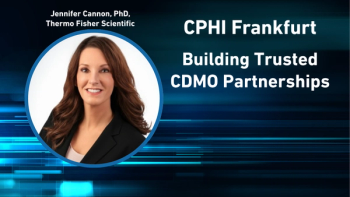
- Pharmaceutical Technology-05-02-2008
- Volume 32
- Issue 5
CMOs are Planning for the Last War
CMO business models are out of touch with current pharma industry realities. It's time for new thinking.
Contract research organizations (CROs) offering clinical research services had a terrific year in 2007. Revenues of the publicly-traded clinical CROs jumped 20% during the year, well ahead of the respectable 15% growth they achieved in 2006. What is really eye-popping is the phenomenal performance of some of the largest CROs. Kendle International (Cincinnati), which had 2006 revenues of $283 million, grew 40% in 2007 to $398 million. ICON (Dublin) grew almost as fast when it jumped to $631 million in 2007 from $455 million in 2006. Parexel (Boston) grew its revenues 25% to $741 million.
Jim Miller
The large clinical CROs benefited from several favorable trends, including growth in the drug development pipeline and efforts by the major pharmaceutical companies to reduce the number of vendors they work with. At the same time, however, big CROs are reaping the benefits of important investments they've made in recent years in anticipation of changes in the pharmaceutical industry. These changes include:
- Greater capabilities in electronic data capture and management are helping to feed back trial results faster
- Expanding networks of offices and clinical site relationships in Asia, Eastern Europe, and Latin America are opening doors to more patients and establishing new markets
- Increased clinical pharmacology capacity is serving the expanding Phase I pipeline and the emphasis on proof of concept
- Scalable organizational models are enabling companies to improve service quality as they grow.
Tough going for CMOs
While it was a blow-out year for clinical and preclinical CROs (toxicology services grew 21%), the year was dismal for contract manufacturing organizations (CMOs). For the second straight year, the dose manufacturing and small-molecule active pharmaceutical ingredient (API) segments experienced overall growth of less than 5%. CMOs were hurt by a number of factors, including the shrinking number of new drug application and biologic license application approvals coming out of the US Food and Drug Administration, declining sales for key client products, clients repatriating products as utilization of their in-house manufacturing assets falls, and overcapacity that generates increased price competition. The two bright spots in the manufacturing universe were biomanufacturing (cell culture and fermentation) and manufacturing of clinical-trial supplies.
A look at the new pharamceutical environment
The immediate prospects for CMOs could improve if their clients are able to get more products approved in the next year or so. However, CMOs may be in trouble over the longterm because most of them continue to operate with business models and strategies based on old perceptions that don't reflect the current realities of the pharmaceutical industry. This is especially true in several key areas outlined below.
Market growth. Most CMO strategies were established in the early part of this decade, and included substantial capacity expansions and aggressive acquisition campaigns. This was a time when new product approvals were expected to be plentiful, and drug prices and unit volumes were rising. The assumption was that growth would continue, meaning there would always be a need for capacity and CMOs could expect annual price increases. It was also a time when industry assumed "price doesn't matter" (i.e., drug sales were so high and profitable that pharmaceutical companies were more concerned about assuring a dependable supply than they were about the cost of goods).
The pharmaceutical industry's growth prospects have changed considerably in the past few years. FDA approvals have continued a 10-year decline, governments and private insurers have fought back against drug-price increases, and safety concerns and utilization guidelines are limiting the growth of blockbuster drugs, especially biologics.
Emerging markets. Five years ago, CMOs geared their strategies to the North American and European markets, where prices were highest and usage was growing most rapidly. CMOs geared their facility design and quality assurance practices to meet FDA and European Medicines Agency (EMEA) standards of compliance.
Today, the market focus of the major pharmaceutical companies is turning to the emerging economies, the so-called "BRIC" countries (Brazil, Russia, India, and China). Serving these countries is an entirely different challenge: they either have their own stiff regulatory requirements, as in the case of Brazil, or lower compliance standards that make the costs of maintaining FDA and EMEA compliance uneconomic. In many cases, laws and/or regulatory practices require local manufacture and discourage imports. Most Western CMOs lack facilities in the emerging economies to take advantage of these expanding opportunities.
Manufacturing and sourcing strategies. While major pharmaceutical companies have made major announcements about their intentions to outsource more, they have continued to invest heavily in new facilities and equipment, especially for development and manufacture of large-molecule products. Capital investment by the 15 largest pharmaceutical companies grew 14% in 2007 to almost $22 billion. With the major pharmaceutical companies on a spree to acquire or in-license large-molecule candidates, the high-value opportunities that CMOs were counting on are likely to be staying in-house.
CMOs are also being hurt by sourcing strategies that are increasingly global. Not only has global sourcing introduced new low-cost competitors in countries such as India and China, it has also greatly extended the pharmaceutical supply chain. Dose CMOs more frequently are dealing with the inability of clients to ship adequate supplies of APIs, resulting in schedule disruptions and revenue shortfalls.
Like the French military planners that built the Maginot Line after World War I, CMO executives find that the scenario they planned for is no longer relevant. In next month's column, I'll cover what the new CMO business model might look like going forward.
Jim Miller is president of PharmSource Information Services, Inc., and publisher of Bio/Pharmaceutical Outsourcing Report, tel. 703.383.4903, fax 703.383.4905,
Articles in this issue
over 17 years ago
Requiem for a Vaccineover 17 years ago
Report from Europeover 17 years ago
Converging InformationTechnology & Automation Teamsover 17 years ago
Florida Builds its Position in the Life Sciencesover 17 years ago
Unplugged: Developing Standards for Wireless Automationover 17 years ago
Dissolving the InsolubleNewsletter
Get the essential updates shaping the future of pharma manufacturing and compliance—subscribe today to Pharmaceutical Technology and never miss a breakthrough.




